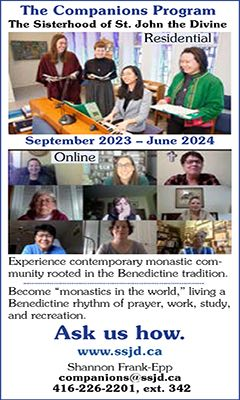Zoom brings intimacy and accessibility
Perhaps I was one of the lucky ones. Having beloved family and friends living all over North America, I already knew Zoom worked. Because of Zoom, I could feel close to far away dear ones. That was not the story for most people when the pandemic lockdown began. Among our parish members, I heard responses ranging from “I’m not a computer savvy person” to “I can use it but I don’t like it” to a simple and clear “No way!” Nevertheless, many jumped in. What choice did we have? Parish council, wardens, and committee meetings needed to continue. And they did: on Zoom. Still, resistance and discomfort with computers and the Internet made Zoom seem an unfriendly and inaccessible “thing” to many.
One year on, this feeling has radically shifted. In our church, study groups (Advent, Lenten) are thriving. The numbers are growing. Those who were originally resistant or adamant that Zoom was not for them have changed their minds. Why? How did this happen?
Christmas had a lot to do with it: aching and yearning hearts were eased by Zoom time with family. Turns out Zoom could be a friend, not an obstacle or the enemy. Christmas presents of tablets and iPads arrived. Technology and devices were updated. Frustrating experiences due to outdated equipment and limited Internet access diminished. Emmanuel, God-with-us working in mysterious ways, doing infinitely more than we could ask or imagine!
And it also turns out Zoom facilitates a transformation in group dynamics. With delight, I watched study groups grow in intimacy, in their willingness to be vulnerable, in a tender sharing and exposure of growing edges. People were talking about loving the groups. Word was spreading. More people were signing up. What was going on?
First, I think using Zoom allows us to operate from our safest place: our homes. And we can show as much or as little of our home as we wish by how we situate ourselves. We can give others a glimpse of who we really are by what we choose to show. I think of Bishop Logan “Zooming” with us from his kitchen, a bright and friendly place. I think of various clergy “Zooming” services from their homes, offering intimacy and vulnerability, and sharing the burden of lockdown restrictions. I think of people doing prayers from their gardens.
Zoom allows us to share with others what we treasure and appreciate: photos of family, bits of nature, beautiful art, colours, textures, the quality of light in a room — all ways of giving glory to God, of thanking God for our lives. It’s a far cry from the “church basement” habitat we tend to accept as adequate space for encountering the Spirit. Beauty, safety, and comfort do feed our souls, nourish kindness, and invite us closer to God.
With Zoom, we focus in on each other’s faces. Close up and intimate, we can see the nuances and subtleties of expressions as people reach for words to articulate their spiritual explorations. It’s like a one-on-one conversation. And everyone can hear! What a boon to not miss out on things because of not catching all the words. Those who are hard of hearing know how awkward it is to be constantly asking people to repeat things. No more of that!
Also, it’s immediate. We turn on our computer, everything is at hand, no need to drive or gather things together before leaving. Driving on dark roads at night — a challenge for many — is not necessary. All voices are heard from as we go round the screen. An increased awareness of giving each person equal air time seems to prevail. The arrangement of windows is not the same on everyone’s screens, so each participant invites the next person to go, creating further connections.
There are limitations. The optimal number of people in a group seems to hover around nine. Perhaps that is our comfort zone for the number of faces we can hold in our awareness at one time. Increasing numbers beyond that seems to create a concurrent decrease in that beautiful intimacy. With more than nine or ten, people become more cautious, less willing to show vulnerability. And then intimacy and deeper sharing takes a hit. There are limits, too, to our ability to sit still in front of a screen. Meeting for an hour leaves people wanting more. Meeting for longer than that seems to exhaust concentration and engagement. People can get “Zoomed out” and become wary of the experience.
So now, moving forward, we can remember those familiar phrases: “The church will never change.” Or how about, “Change in the church is glacial”? Or maybe the cry of the frustrated: “We’re called to be the church of Christ, not the historical society of Christ!” Zoom, agent of change and transformation in the church. Who knew! This is something we want to take with us into our brave new future. Thanks be to God for opening our collective minds and hearts to this way of being together.



